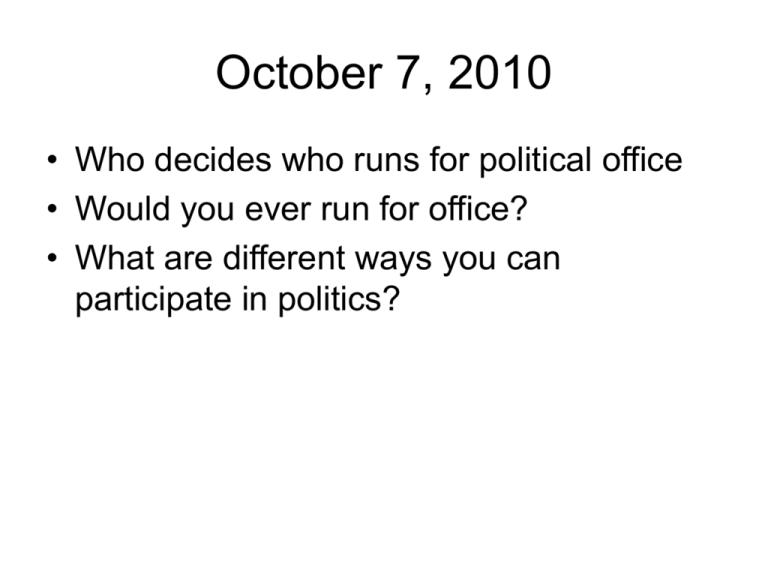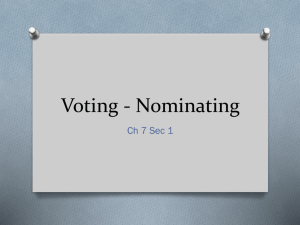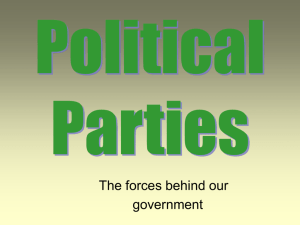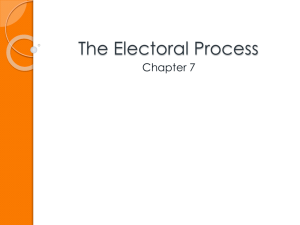Elections
advertisement

October 7, 2010 • Who decides who runs for political office • Would you ever run for office? • What are different ways you can participate in politics? In the United States, the election process occurs in two steps: 1. Nomination, in which the field of candidates is narrowed, usually in primary elections. 2. General election, the regularly scheduled election where voters make the final choice of officeholder Nominating a Candidate A person who wants to run for office announces their candidacy. A write-in candidate appears on the ballot. Self-announcement process has been used. Nominating a Candidate The Caucus – Originally a private meeting of local bigwigs, the caucus as a nominating device fell out of favor in the 1820s. The Convention – Considered more democratic than the caucus, convention delegates were selected to represent the people’s wishes. Party bosses soon found ways to manipulate the system, however, and the convention system was on its way out by the early 1900s. Nominating a Candidate Party members vote in public elections to decide which candidate they want to represent their party in the general election. Types of Direct Primaries Closed Primary Only declared party members can vote. New Mexico, Oklahoma Open Primary Any qualified voter can take part. Texas Nonpartisan Primary Candidates are not identified by party labels Runoff Primary If a required majority is not met, the two people with the most votes run again California Blanket Primary Qualified voters can vote for any candidate, regardless of party Primaries Across the United States Nominating a Candidate • Candidates must gather a required number of voters’ signatures to get on the ballot by means of petition. • Minor party and independent candidates are usually required by State law to be nominated by petition. • Petition is often used at the local level to nominate for school posts and municipal offices. Nominating and Electing a Candidate Assessment 1. The most commonly used method of nomination today is (a) the caucus. (b) the direct primary. (c) self-announcement. (d) the convention. Assessment 1. The most commonly used method of nomination today is (a) the caucus. (b) the direct primary. (c) self-announcement. (d) the convention. Assessment 2. A runoff primary is held in some States when (a) no one wins a majority of votes. (b) there is only one candidate. (c) not enough voters turn out on election day. (d) a candidate asks for a recount. Assessment 2. A runoff primary is held in some States when (a) no one wins a majority of votes. (b) there is only one candidate. (c) not enough voters turn out on election day. (d) a candidate asks for a recount. The Administration of Elections Election procedures are decided by States, but there are some federal rules. Congress • Sets the time, place, and manner of congressional and presidential elections. • Chose the first Tuesday after the first Monday in November of every even-numbered year for congressional elections, the presidential election being held the same day every fourth year. States • Determine the details of the election of thousands of State and local officials. • Absentee voting, for voters who are unable to get to their regular polling places on election day. • Early Voting, Some States within the last few years have started to allow voting a few days before election day to increase voter participation. Precincts and Polling Places Precincts • Are voting districts. • They are the smallest geographic units used to carry out elections. Polling Places • Are where the voters who live in a precinct go to vote. They are supposed to be located conveniently for voters. History of the Ballot • Voting was initially done orally. It was considered “manly” to speak out your vote without fear of reprisal. • Paper ballots began to be used in the mid to late1800s. At first, people provided their own ballots. Then, political machines began to take advantage of the flexibility of the process to intimidate, buy, or manufacture votes. • In the late 1800s, ballot reforms cleaned up ballot fraud by supplying standardized, accurate ballots and mandating that voting be secret. Voting Machines and Innovations • Electronic vote counting has been in use since the 1960s. Punch-card ballots were often used to cast votes. • Vote-by-mail elections have come into use in recent years. • Online voting is a trend that may be encountered in the near future. Assessment 1. Elections are held on (a) the first Wednesday after Halloween. (b) the first Tuesday after the first Monday in November. (c) the second Thursday after the first Monday in March. (d) the first Monday in December. Assessment 1. Elections are held on (a) the first Wednesday after Halloween. (b) the first Tuesday after the first Monday in November. (c) the second Thursday after the first Monday in March. (d) the first Monday in December. Assessment 2. The Office-Group Ballot encourages (a) voter fraud. (b) split-ticket voting. (c) voter dissatisfaction. (d) the Democratic Party. Assessment 2. The Office-Group Ballot encourages (a) voter fraud. (b) split-ticket voting. (c) voter dissatisfaction. (d) the Democratic Party. Campaign Spending Private and Public Sources of Campaign Money Small contributors Wealthy supporters Candidates Temporary fund-raising organizations Nonparty groups such as PACs Government subsidies Regulating Campaign Financing • The Federal Election Campaign Act (FECA) of 1971 was passed to replace other, ineffective legislation. The Federal Election Commission (FEC) enforces: • the timely disclosure of campaign finance information • limits on campaign contributions • limits on campaign expenditures • provisions for public funding of presidential campaigns Assessment 1. Sources of campaign funding include (a) nonparty groups, such as political action committees. (b) government subsidies. (c) candidates’ personal funds. (d) all of the above. Assessment 1. Sources of campaign funding include (a) nonparty groups, such as political action committees. (b) government subsidies. (c) candidates’ personal funds. (d) all of the above. Assessment 2. Under federal election legislation passed in the 1970s, candidates are not allowed to (a) take government subsidies. (b) use their own money in campaigns. (c) take contributions of more than $1,000. (d) all of the above. Assessment 2. Under federal election legislation passed in the 1970s, candidates are not allowed to (a) take government subsidies. (b) use their own money in campaigns. (c) take contributions of more than $1,000. (d) all of the above.





